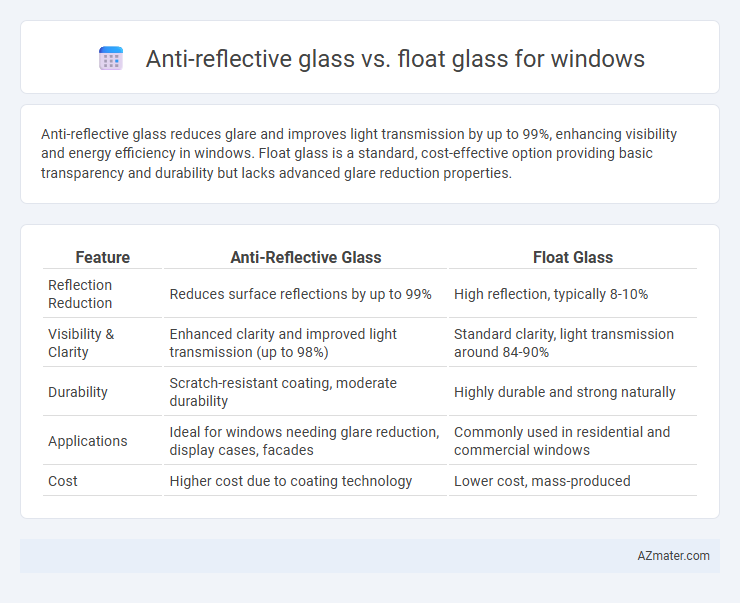Anti-reflective glass reduces glare and improves light transmission by up to 99%, enhancing visibility and energy efficiency in windows. Float glass is a standard, cost-effective option providing basic transparency and durability but lacks advanced glare reduction properties.
Table of Comparison
| Feature | Anti-Reflective Glass | Float Glass |
|---|---|---|
| Reflection Reduction | Reduces surface reflections by up to 99% | High reflection, typically 8-10% |
| Visibility & Clarity | Enhanced clarity and improved light transmission (up to 98%) | Standard clarity, light transmission around 84-90% |
| Durability | Scratch-resistant coating, moderate durability | Highly durable and strong naturally |
| Applications | Ideal for windows needing glare reduction, display cases, facades | Commonly used in residential and commercial windows |
| Cost | Higher cost due to coating technology | Lower cost, mass-produced |
Introduction to Anti-Reflective Glass and Float Glass
Anti-reflective glass reduces glare and enhances light transmission by minimizing surface reflections, making it ideal for window applications requiring clear visibility and better aesthetics. Float glass, produced through the float process, provides a smooth, flat surface with uniform thickness, serving as a cost-effective and versatile base material for windows and other architectural uses. Comparing both, anti-reflective glass offers superior optical clarity, while float glass emphasizes affordability and structural consistency.
How Anti-Reflective Glass Works
Anti-reflective glass reduces glare and reflections by using multiple thin layers of metal oxides coated onto the glass surface, which create destructive interference for reflected light waves. This coating allows more natural light to pass through the window while minimizing visual distortions and enhancing clarity compared to standard float glass. The improved light transmission of anti-reflective glass makes it ideal for applications requiring high visibility and aesthetics, such as storefronts and touchscreen displays.
What is Float Glass?
Float glass, also known as annealed glass, is produced by floating molten glass on a bed of molten metal, typically tin, to create a uniform thickness and smooth surfaces. It is widely used for windows, allowing natural light while providing basic insulation and weather resistance. Unlike anti-reflective glass, float glass lacks special coatings to reduce glare and reflections, making it more affordable but less effective in enhancing visual clarity.
Comparing Light Transmission: Anti-Reflective vs Float Glass
Anti-reflective glass significantly improves light transmission by reducing surface reflections to below 1%, compared to float glass which typically reflects about 8-10% of incoming light. This higher light transmission rate enhances natural daylighting, minimizes glare, and improves visual clarity in window applications. Float glass, while more affordable and widely used, often leads to increased energy loss and reduced optical performance in comparison to anti-reflective glass.
Clarity and Visibility Differences
Anti-reflective glass significantly enhances clarity and visibility by reducing surface reflections and glare, allowing more natural light to pass through compared to float glass. Float glass often produces visible reflections and can distort views due to its higher reflection rates and lower light transmission. The advanced coating on anti-reflective glass improves optical clarity, making it ideal for windows in environments requiring unobstructed, clear views.
Energy Efficiency and UV Protection
Anti-reflective glass significantly enhances energy efficiency by minimizing solar heat gain while allowing maximum natural light transmission, reducing the need for artificial lighting and cooling. It offers superior UV protection by blocking up to 99% of harmful ultraviolet rays, preventing interior fading and damage. In contrast, standard float glass lacks these specialized coatings, resulting in higher heat transfer and less effective UV filtration, which diminishes overall energy savings and indoor comfort.
Durability and Maintenance Requirements
Anti-reflective glass features a durable coating that resists scratches and reduces glare, enhancing long-term performance compared to float glass's standard surface. Float glass, while more affordable, is prone to surface scratches and smudges that require frequent cleaning to maintain clarity. Maintenance for anti-reflective glass is minimal due to its protective layer, whereas float glass demands regular upkeep to prevent deterioration and maintain transparency.
Cost Comparison: Anti-Reflective Glass vs Float Glass
Anti-reflective glass typically costs 20-30% more than standard float glass due to advanced coatings that reduce glare and improve visibility. Float glass remains the most economical option for basic window applications, with prices averaging $5 to $10 per square foot, whereas anti-reflective glass ranges from $7 to $13 per square foot. The higher initial investment in anti-reflective glass may result in long-term benefits by enhancing natural light transmission and reducing energy costs.
Best Applications for Each Glass Type
Anti-reflective glass is ideal for high-performance display windows, museums, and storefronts where reducing glare and maximizing light transmission are critical to enhancing visibility and visual clarity. Float glass is best suited for general construction and residential windows due to its cost-effectiveness, smooth surface, and versatility in thickness and size. Choosing the right glass type depends on application specifics such as the need for glare reduction, optical clarity, and budget constraints.
Choosing the Right Glass for Your Windows
Anti-reflective glass reduces glare and enhances clarity by minimizing light reflection, making it ideal for windows in bright environments or spaces requiring optimal visibility. Float glass offers a cost-effective and versatile option with a smooth surface and good optical quality but may cause more glare in direct sunlight. Selecting the right glass involves balancing factors such as light transmission, aesthetics, energy efficiency, and cost based on the specific window application and environmental conditions.

Infographic: Anti-reflective glass vs Float glass for Window
 azmater.com
azmater.com